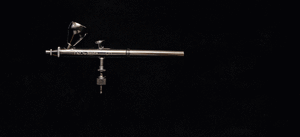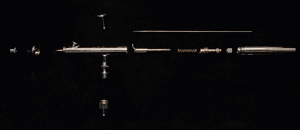Airbrush Area
This page is INCOMPLETE and still missing some important information before it can be used as a resource. Please use the "Discussion" feature above or talk to one of the tutors if you would like to help improve it. Thanks!
This page is work in progress. We are aiming to open the new airbrush area in Q1/2024.
The airbrush area is located in the electronics room and contains our airbrush related tools and machines. Not just for creating beautiful airbrush art, but also for painting 3D-printed models and other materials. Using an airbrush is easy, fun to learn – and a lot better for the environment than spray cans.
Airbrush Colors
Dedicated airbrush paints are usually water-based acrylic paints, with a milk-like consistency.
Schmincke AERO COLOR is very high quality, and ready-to-use without the need to mix/dilute any further. (Besides their large selection of readymade colors, they even offer instructions or "recipes" on how to mix RAL colour tones).
Be careful when using cheap / no-name airbrush-paints, as you may have to thinnen them with a dedicated medium and/or distilled water. The same of course applies to any "non-airbrush" paints. An airbrush is a precision tool, with very fine nozzle diameters ranging between 0.2 and 0.5mm. If your paint is too thick, it will clog your nozzle within a few seconds.
Best case scenario: you'll have to disassemble and clean the airbrush.
Worst case scenario: the clogged nozzle spills paint blobs onto your beautiful piece of art!
Spray Booth
Make sure you always have the spray booth's air extractor turned on. The spray booth we've built should be large enough for nearly all your projects, be it a A1-sized airbrush painting, or a t-shirt, shoes etc.
At the rear of the spray booth, you'll see a metal plate which can be tilted towards you, for a convenient viewing angle.
For painting miniator figures / 3D-printed models etc: you'll find a turntable in one of the drawers.
How to connect the airbrush to the compressor
To connect the compressor hose to the airbrush, please use the adaptor piece. The compressor will keep its pressure even if no airbrush is connected.
Compressor settings
Cleaning the airbrush
Cleaning is mandatory after every session. Even during a session, be aware that paint can dry quickly and clog the airbrush. If you interrupt your airbrush session even for as little as 5 Minutes: please remove any remaining paint AND rinse the airbrush with water and a few drops of cleaning agent, using the dedicated cleaning jar.
At the end of the session (if no one else wants to continue using the airbrush corner): please clean the airbrush thoroughly, following these instructions: (This should take around 15 Minutes, so don't leave it too late.)
- remove any remaining color from the compartment
- fill the compartment with water and run it through the airbrush (Please use the rinsing jar for this, so to collect all coloured water and residue)
- disconnect airbrush from compressor
- disassemble the entire airbrush on a large enough and clean surface; make sure no parts fall down, particularly the needle (€15 replacement cost!) – see animated GIF below
- clean all parts, removing ALL visible paint. Please do not use any metal brushes for cleaning.
- reassemble the airbrush and put it back into its case – see animated GIF below
Animated GIFs that show the disassembly and reassembly of our Iwata Neo CN airbrush.
Airbrush disassembly (click image, then on the following page click "open in Media Viewer")
Airbrush reassembly (click image, then on the following page click "open in Media Viewer")
Airbrush-Corner Induction
This is the content required for an induction to our Airbrush Corner. Reading this does NOT replace the mandatory session with a tutor! It will make it a lot quicker though ;-)
If you need this Introduction, please reach out to the following tutors: Björn
Health & Safety Precautions
| Danger | Description | Precautions |
|---|---|---|
| Aerosols | Airbrushing creates aerosols / vapours. Although most airbrush paints are typically water-based, you don't want to inhale those aerosols / paint particles. | use spray booth;
use respirator (grade A2 P2) |
| Airbrush needle | Every airbrush gun has a needle inside. The needle is usually covered/protected, but will become accessible when you disassemble the airbrush for cleaning. | Handle with care |
| Compressor | compressed air is generated and released through the airbrush:
|
|
| Spray Booth | The spray booth contains an adjustable metal plate, which is attached to two hinges at the top. When reverting the metal plate to its standard vertical position, make sure your fingers don't get caught. | Grab the metal plate on the left/right side, NOT underneath. |
| Paint fumes | Paint aerosols might travel away from the airbrush corner. We want protect our beautiful 3D-Printers. | use spray booth;
close the curtain behind you |
Practical Demonstration
- show airbrush and needle functionality before connecting airbrush to compressor
- connect airbrush to compressor
- change compressor pressure settings
- add paint / change paint
- spray examples with varying needle positions (fine line / area fill etc)
- disconnect airbrush from compressor
- empty compressor / use valve
- disassemble airbrush
- clean airbrush
- reassemble airbrush

